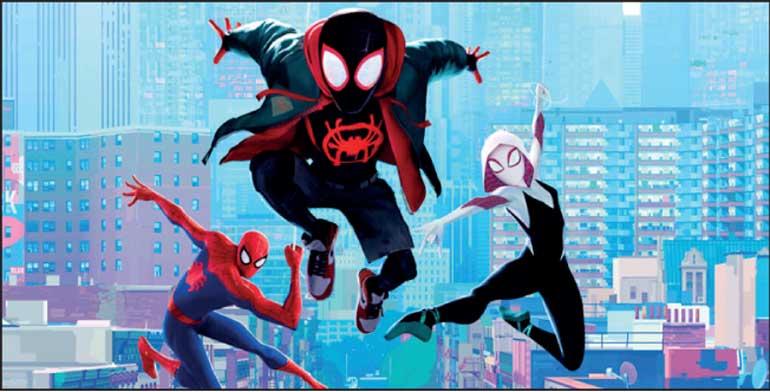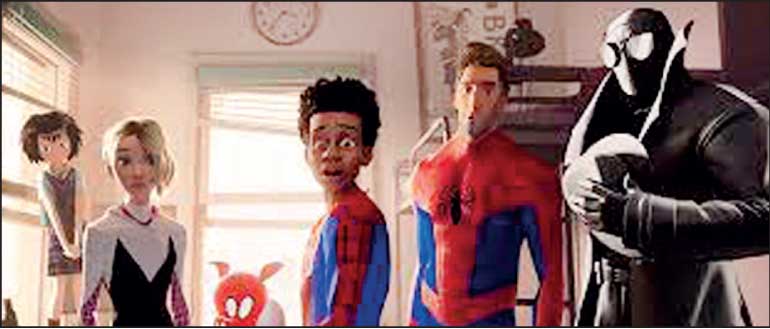Sunday Apr 20, 2025
Sunday Apr 20, 2025
Saturday, 3 June 2023 00:15 - - {{hitsCtrl.values.hits}}


LOS ANGELES, AFP: Nearly five years after the animated “Spider-Man: Into the Spider-Verse” won an Oscar with its innovative, biracial take on the beloved webslinger, a wildly ambitious sequel aims to further blur the boundaries between superhero films and arthouse cinema.
“Spider-Man: Across the Spider-Verse,” released yesterday in cinemas picks up the story of half-Black, half-Latino Miles Morales, again using an eye-popping blend of decades-old 2D comic book drawing techniques with the latest computer-generated visual effects.
This time, the action takes place across several parallel universes, each one visualised in its own unique animated style, from a paint-streaked, grungy 1990s New York to a kaleidoscopic futuristic hybrid of Mumbai and Manhattan.
The movie employed three directors, more than 1,000 artists, and runs at two hours and 20 minutes – unusually long for an animated film.
Its creators told AFP that the success of the first movie – which holds the highest-ever rating for a superhero movie on Rotten Tomatoes (97%) – “gave us permission to just be even more daring on this film.” “I feel like we got the amazing opportunity as directors to make the world’s biggest independent film, basically,” said co-director Justin K. Thompson.
“It’s an arthouse film, disguised as a superhero movie.” - ‘The Spider-Verse’ - The film’s hero Morales was first introduced to comic books in 2011, but came to mainstream attention with “Into the Spider-Verse,” which won the Academy Award for best animated feature in 2019.
Morales shares a familiar backstory with Peter Parker – bitten by a radioactive spider, he quickly deploys his new powers to swing between Manhattan skyscrapers and fight crime.
But his diverse ancestry and fondness for trendy sneakers and rap music set him apart from the “traditional” Spider-Man.
It is all made possible thanks to the concept of a “multiverse,” in which different versions of the same characters exist in parallel dimensions – and occasionally interact – that has been used in comic books for decades.
In recent years, the multiverse has become popular in Hollywood too, as movie studios feed audiences’ boundless appetite for more and more superhero films, and writers scramble to explain how they can possibly all fit together.
And “Across the Spider-Verse” is the first of two sequels, with “Beyond the Spider-Verse” to conclude events next year.
Discover Kapruka, the leading online shopping platform in Sri Lanka, where you can conveniently send Gifts and Flowers to your loved ones for any event including Valentine ’s Day. Explore a wide range of popular Shopping Categories on Kapruka, including Toys, Groceries, Electronics, Birthday Cakes, Fruits, Chocolates, Flower Bouquets, Clothing, Watches, Lingerie, Gift Sets and Jewellery. Also if you’re interested in selling with Kapruka, Partner Central by Kapruka is the best solution to start with. Moreover, through Kapruka Global Shop, you can also enjoy the convenience of purchasing products from renowned platforms like Amazon and eBay and have them delivered to Sri Lanka.
Discover Kapruka, the leading online shopping platform in Sri Lanka, where you can conveniently send Gifts and Flowers to your loved ones for any event including Valentine ’s Day. Explore a wide range of popular Shopping Categories on Kapruka, including Toys, Groceries, Electronics, Birthday Cakes, Fruits, Chocolates, Flower Bouquets, Clothing, Watches, Lingerie, Gift Sets and Jewellery. Also if you’re interested in selling with Kapruka, Partner Central by Kapruka is the best solution to start with. Moreover, through Kapruka Global Shop, you can also enjoy the convenience of purchasing products from renowned platforms like Amazon and eBay and have them delivered to Sri Lanka.